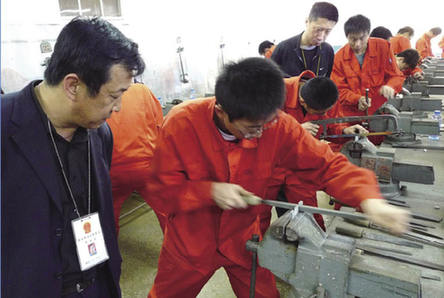| Vocational Training: A Key to Unlock the Job Market
By MAN KAIYAN, QI JIELUN & YANG ZHENGWEN
|
 |
|
Students in a trade school in Dalian are completing advanced benchwork certification. |
THE world economic crisis is heightening the tension of young job-seekers in China, with neither migrant workers nor college graduates spared its devastating impacts. Many experts believe widespread lay-offs and joblessness in these groups could be mitigated by the promotion of vocational training. The strategic arguments are persuasive, and challenge common notions about the value of respective kinds of work.
Graduates in Oversupply; Trades in Demand
Late last year, the Ministry of Education (MOE) gave notice that the master program enrolment capacity must increase by five percent. This is the second time MOE has enlarged the scale of graduate schools, the last being in 1999 when colleges nationwide experienced unprecedented demand for enrolment. That academic achievement is no guarantee of a job was underscored just four years after this first expansion. The swell in the ranks of the college educated – to some six million from 1.8 million in 1998 – soon brought on the job-hunting difficulties of 2003. Temporary measures such as this are again expected to create a buffer area for job hunters and a way out for struggling graduates, but they could also become the foundation for more proactive human resource development strategies.
Some critics feel accepting more students into current college programs will simply postpone a review of what kinds of labor pools a national policy needs to stimulate. An academic preparation "won't necessarily improve a graduate's employability, and it certainly doesn't offer a radical solution to satisfying actual labor market demand," cautions MOE research fellow Jiang Dayuan of the Research Institute for Vocational Education. "If we can't jump out of the educational circle to deal with education, if we can't jump out of the college circle to deal with college issues, if we can't jump out of the problem itself to resolve it within the wider social context, the graduates will still fail to find jobs. If the content of college programs isn't up to date, nor the teaching methods, students' skills and knowledge will fail to answer the demands of enterprises and society."
Chen Yu, deputy director of the China Association of Employment Advocacy, believes that the country is experiencing changes dramatic enough to justify more constructive and universal solutions. He points out the volume of high school graduates going on to attend college now stands at 25 percent, much higher than the 5 percent of 1999. Even so, Chen doubts the supply will fit the demand. According to his figures, the approximately 10 percent growth rate maintained by the Chinese economy for the last few years has significantly enlarged its appetite for talent. "If one percentage of growth per annum needs to be matched by a million laborers, then ten percentage points call for ten million more laborers every year. "But," he echoes Jiang's concerns, "only one tenth of the 10 million jobs are fit for college students."
Various influences on China's economy have affected educated and uneducated workers alike. Unskilled labor has generally been regarded as sufficient for export-based and labor-intensive manufacturing industries. In these enterprises, the opportunity to generate value-added revenue is low, and advanced technical and academic requirements therefore unnecessary. Such sectors could be staffed by migrants rather than a formally trained and skilled workforce. Starting with the reform and opening-up period, however, the modernization of industry boosted the popularity of trade vocations. By 1998, about 58 percent of high-school-aged teenagers elected to gain various technical competencies at vocational schools. However, the figure dwindled to 38 percent in 2002, and although it rebounded by a small percentage recently, it has not regained the peak of the last decade. That situation could change, and some argue that it should change.
Leaders in education have cited the shortage of vocational training slots directly contributes to the problem of unemployment. "There is an imbalance between those with a standard education and those accredited to practice a trade – the former is too robust while the latter too lame," asserts former president of Wuhan University Liu Daoyu. Vocational education isn't the poor relative of higher education in this school of thought. Instead, they complement each other. Xia Yeliang, deputy director of Foreign Economics Research Center, Peking University, clarifies the relationship, "The standard academic education supports research in, and refinement of our humanities and sciences, while vocational schools concern themselves with the application of current techniques and technologies." Unfortunately the latter have been in decline when it appears they need to expand.
|
 |
|
A student at the Beijing Secior High School of Foreign Affairs tries his hand at watermelon carving. |
"People used to think those taking up a vocation were simply less smart, which is totally misinformed," researcher Jiang commented. Today the system can hardly meet the demand for these skills. Issues of quality are as worrisome as volume. Some college teachers lack practical experience in the fields they teach and find themselves in any case unable to keep up with the latest technical advances in those trades. For example, training migrant workers is one of Beijing Fuping School's undertakings. "Initially, they invited some retired professors and specialists," Dean Luan Shunxi recalled, "but it turned out that their teachings were too theoretical for our trainees, some of whom had just finished primary school. The lessons just confused them."
Continuing education faculties and community colleges are mainstays of schooling options abroad, whether they cater to the professional development of mature students, to older workers re-skilling for a return to the workforce, or to the emerging workforce seeking to benefit by deficits in technical trades. "In many foreign countries, community colleges provide practical degree programs, sometimes at the Masters level," said Xia Yeliang of Peking University. "This kind of college is more egalitarian. Open to young adults and even seniors, they are specifically designed to be flexible to market demand." Xia admits their lack here is a great regret, "but the financial crisis grants us a good opportunity to develop such a system."
Job market data confirms that the employment rate for over 16,000 vocational graduates is an impressive 95 percent. "This is the feedback from the labor market," Chen Yu concludes, "so if trade schools take normal universities as a development model, they'll have no future."
The Case of Migrant Workers
Large-scale lay-offs of migrant workers in the coastal manufacturing industries are also a legacy of the current crisis that is stimulating deeper analysis. How to train workflows on the move, fluctuating between the countryside and urban areas, is just the first question testing the responsiveness of central and local governments, who are responding in various ways. Progress is slow and communications between government, enterprises, workers and job fair organizers are, so far, not smooth. Here too, industrial and educational leaders are looking for more comprehensive and forward-thinking measures.
|
